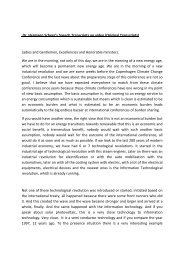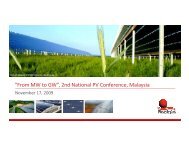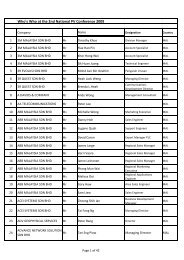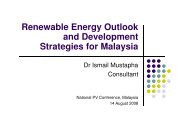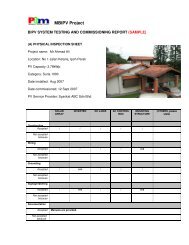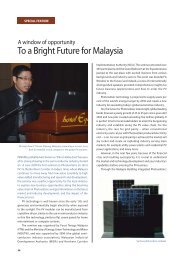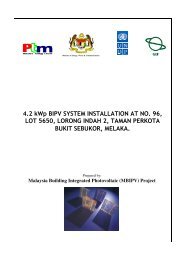MBIPV Project Brief
MBIPV Project Brief
MBIPV Project Brief
You also want an ePaper? Increase the reach of your titles
YUMPU automatically turns print PDFs into web optimized ePapers that Google loves.
ANNEX A: INCREMENTAL COST ANALYSISBROAD DEVELOPMENT GOALS1. Since independence in 1957, Malaysia has undergone tremendous growth and prosperity byshifting the economic activities from labor-intensive industries to energy and capital-intensiveindustries, particularly heavy industry. In recent years, Malaysia’s energy consumption hasincreased and comparable to larger energy consumers world-wide. In 2002 the energyconsumption was 2.8 MWh per capita and estimations show a significant increase in the energydemand. The supply for the demand is focused on coal and gas. However, there is a growingawareness and concern in the supply of energy particularly on the issue of carbon emissions andglobal warming. Under the Third Outline Perspective Plan (OPP3), the government isundertaking efforts to manage both non-renewable and renewable energy (RE) resources to caterfor the demand of the rapidly growing economy.2. In line with the Fifth Fuel objectives of the Government of Malaysia (GoM) and its energytargets in the next 5 years, the Malaysia BIPV Technology Application <strong>Project</strong> (<strong>MBIPV</strong>) wasconceived with the primary aim of reducing the long-term BIPV system cost by establishingsustainable and widespread BIPV technology applications that will offset the greenhouse gas(GHG) emissions from the electricity supply industry. Subsequently the project can be replicatedto neighboring countries and thus contributing a significant input on the overall global reductionof GHG emissions.3. This proposed project seeks GEF’s support to ensure that the GHG emissions from the fossilfuel-fired power generation is reduced through the utilization of PV in the building (BIPV) asviable alternative energy sources, as well as improving the energy efficiency of the buildingsectors.BASELINE SCENARIO4. The baseline conditions for this project consists of what the GoM would do without GEF support.BIPV technology remains untapped mainly due to its relatively high cost and the generalperception that the technology is ‘exotic’ and ‘unproven’ in Malaysia. Without this project, thecountry would have limited success in establishing a suitable environment for widespreadadoption of grid-connected BIPV technology as a viable RE technology. The current GoM’simplementation strategy is to focus on EE and biomass. PV receives some focus mainly in ruralapplications (stand-alone systems) especially in Sabah and Sarawak. However, the synergisticpotential of BIPV with the building industry and its impact on demand side managementespecially peak demand has not been fully recognized.5. Considering the business-as-usual scenario, the few activities and implementation lead touncoordinated efforts, characterized by no improvement in quality issues, policy and institutionaldeficiencies, inadequate investment in improving the technical skills and no cost reduction for thetechnology. A sustainable market and thus cost reduction achieved through improvement oftechnical skills, better procurement and lower transaction costs, scale of volume and localmanufacturing cannot be established without the proposed activities. The few present andplanned activities of the MECM, ST, MESITA-fund and SIRIM are complementing the activitiesof the proposed <strong>MBIPV</strong> project and will be integrated. A program on grid-connected PVapplications will only create short-lived impact to the local market. Testing facilities42



